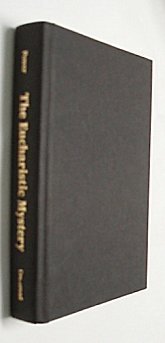

 |

|

The average rating for The eucharistic mystery based on 2 reviews is 5 stars.
Review # 1 was written on 2014-08-11 00:00:00 Mary Blaine Dilles Mary Blaine DillesM. Basil Pennington’s The Eucharist Yesterday and Today viewed the Eucharist as new wine, rich with promise that can only burst old skins. This was seen as “breaking out of the bonds of our ecclesiastical past and enlivening the whole humanity through a Church that is not a confirming old sack, but a gushing source of life and love for every woman, child, and man on the face of the earth.” Pennington describes Eucharist as the coming together to celebrate “a memoria, a sacramental memorial, not only a calling to mind but a making present of the passion, death, resurrection, and ascension of our Lord Jesus Christ.” Through this supreme act of all creation, Christ’s Passover draws to itself everything in creation - “That they may be one, Father, as you in me and I in you, that they may be one in us” for we are being made according to the image of the Creator. Beginning of the Eucharist Each Eucharist begins with a preparatory rite that involves purification and conversion. So when the president speaks the word of absolution we should know of what we are being absolved and receive the healing and purifying grace deep within our being. As a purified people of God gathered together, we constitute a holy place, an indwelling place for God himself. We are the gateway to heaven, there to celebrate in a more transcendent way. It is explained when the officiating president prays for us. His prayer has been traditionally called a collect. He has to collect our prayers, the prayers of the community. So we must have time to pray, to lay before God our Lord the concerns that lie in our hearts, so that they may be collected. The priest then articulates in his collect what has been flowing from the hearts of the assembled gathering. The Liturgy & Homily The liturgy is a school: it effectively teaches us and leads us into reality if we are attentive to what is happening, what is being said. Once again Christ Jesus proclaims his Good News of salvation. As God is truly present in his Eucharist in the tabernacle, he is truly present in his Word on the lectern. How good is the Good News, and all that surrounds it should be good – the best! According to Pennington the homily is the time to hear the Lord and prepare to respond. We assent to the notions, these ideas, the propositions of faith is a gift from the Lord. It requires on our part a certain humility which truthfully acknowledges that God does know more than we do and that it is wise to listen to him. We pray the creed that makes us aware of our dependence. God is the Maker, we are the made; he is the Savior, we are the saved. It makes us aware too how much we are loved: “for us and for our salvation.” It is the climactic moment which is called the Liturgy of the Word. This becomes a moment of communion when the leader of the assembly breaks the bread of the Word and shares its source of life - the living faith. Meanwhile, the people wait for their hungry souls to be filled. In the homily the priest is sharing the two-thousand-year-old story of the historical Jesus of yesterday, today, and the same forever. The Nature of the Mass The elaborate offertory rite that has been developed in the Middle Ages has been set aside and the Mass has been brought back to its simpler origins. “It is much richer – pregnant with symbolism and association. It takes us back to the first Mass, the Last Supper, and our Jewish origins, to the divine liberation from bondage, to salvation history.” Christ himself is all gift. The Eucharist is the great prayer of thanksgiving. This prayer always retains a few variables for great feasts and seasons. Meal and sacrifice are one, meant to bring about true communion. They were to make a memorial of what Jesus did on the night before he died, a ritual act that would reach into God’s now and make historically present the very act of Calvary – his supreme act of sacrificial love. But there is also participating love of every one of his members, his body, who have entered by faithful love into communion with his act of love. Pennington saw heresies when they began to deny that the words of the institution brought about the real presence of the Christ-God in the host and the chalice, the consecrated species were held up to give the faithful a chance to proclaim their belief in the manifest act of adoration. This powerful visual and symbolic proclamation of holding the host and the chalice aloft for a moment gives our faith a chance to be called forth more fully and respond more completely. It is only in this context of a full attitude, life and meditation that a priest can truly pray his priestly prayer at the Mass in a way that will bring forth from the people a wholehearted, empowered “Amen!” A good priest’s generosity and goodness as a person can and should always be affirmed. A positive word of encouragement the people must add, a suggestion or the expression of hope or expectation can have him preside to his fullest potential. |
Review # 2 was written on 2020-11-11 00:00:00 Steven Racic Steven RacicVery good book for understanding, renewing and appreciating the mass of the Catholic Church. |
CAN'T FIND WHAT YOU'RE LOOKING FOR? CLICK HERE!!!